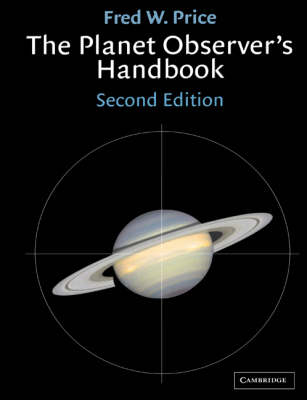
The Planet Observer's Handbook
Seiten
2000
|
2nd Revised edition
Cambridge University Press (Verlag)
978-0-521-78981-3 (ISBN)
Cambridge University Press (Verlag)
978-0-521-78981-3 (ISBN)
This is an informative, up-to-date and well-illustrated guide for amateur astronomers who wish to make useful observations of the solar system planets and asteroids. Highly-detailed practical instructions are provided to observational techniques and the recording and analysis of data.
This is an informative, up-to-date and well-illustrated guide to planetary observations for amateurs. After a brief description of the solar system and a chapter on the celestial sphere, readers are shown how to choose, test and use a telescope with various accessories and how to make observations and record results. For each planet and the asteroids, details are given of observational techniques, together with suggestions for how to make contributions of scientific value. From a general description and detailed observational history of each planet, observers can anticipate what they should see and assess their own observations. The chapter on planetary photography includes the revolutionary use of videography, charge coupled devices and video-assisted drawing. There are also chapters on making maps and planispheres and on photoelectric photometry.
This is an informative, up-to-date and well-illustrated guide to planetary observations for amateurs. After a brief description of the solar system and a chapter on the celestial sphere, readers are shown how to choose, test and use a telescope with various accessories and how to make observations and record results. For each planet and the asteroids, details are given of observational techniques, together with suggestions for how to make contributions of scientific value. From a general description and detailed observational history of each planet, observers can anticipate what they should see and assess their own observations. The chapter on planetary photography includes the revolutionary use of videography, charge coupled devices and video-assisted drawing. There are also chapters on making maps and planispheres and on photoelectric photometry.
Foreword; Preface; Introduction: why observe the planets?; 1. The solar system; 2. The celestial sphere; 3. Telescopes and accessories; 4. The atmosphere and seeing; 5. Mercury; 6. Venus; 7. Mars; 8. The minor planets (asteroids); 9. Jupiter; 10. Saturn; 11. Uranus; 12. Neptune; 13. Pluto; 14. Constructing maps and planispheres; 15. Planetary photography and videography; 16. Photoelectric photometry of the minor planets, planets and their satellites; Name index; Subject index.
| Erscheint lt. Verlag | 26.10.2000 |
|---|---|
| Zusatzinfo | 28 Tables, unspecified; 1 Maps; 82 Halftones, unspecified; 140 Line drawings, unspecified |
| Verlagsort | Cambridge |
| Sprache | englisch |
| Maße | 188 x 248 mm |
| Gewicht | 816 g |
| Themenwelt | Sachbuch/Ratgeber ► Natur / Technik ► Weltraum / Astronomie |
| Naturwissenschaften ► Physik / Astronomie ► Astronomie / Astrophysik | |
| ISBN-10 | 0-521-78981-8 / 0521789818 |
| ISBN-13 | 978-0-521-78981-3 / 9780521789813 |
| Zustand | Neuware |
| Haben Sie eine Frage zum Produkt? |
Mehr entdecken
aus dem Bereich
aus dem Bereich
Buch | Hardcover (2012)
Westermann Schulbuchverlag
34,95 €
Schulbuch Klassen 7/8 (G9)
Buch | Hardcover (2015)
Klett (Verlag)
30,50 €
Buch | Softcover (2004)
Cornelsen Verlag
25,25 €


